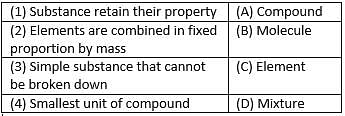UPSC Exam > UPSC Tests > Science & Technology for UPSC CSE > Test: Is Matter Around Us Pure - 2 - UPSC MCQ
Test: Is Matter Around Us Pure - 2 - UPSC MCQ
Test Description
9 Questions MCQ Test Science & Technology for UPSC CSE - Test: Is Matter Around Us Pure - 2
Test: Is Matter Around Us Pure - 2 for UPSC 2024 is part of Science & Technology for UPSC CSE preparation. The Test: Is Matter Around Us Pure - 2 questions and answers have been
prepared according to the UPSC exam syllabus.The Test: Is Matter Around Us Pure - 2 MCQs are made for UPSC 2024 Exam. Find important
definitions, questions, notes, meanings, examples, exercises, MCQs and online tests for Test: Is Matter Around Us Pure - 2 below.
Solutions of Test: Is Matter Around Us Pure - 2 questions in English are available as part of our Science & Technology for UPSC CSE for UPSC & Test: Is Matter Around Us Pure - 2 solutions in
Hindi for Science & Technology for UPSC CSE course. Download more important topics, notes, lectures and mock
test series for UPSC Exam by signing up for free. Attempt Test: Is Matter Around Us Pure - 2 | 9 questions in 10 minutes | Mock test for UPSC preparation | Free important questions MCQ to study Science & Technology for UPSC CSE for UPSC Exam | Download free PDF with solutions
Test: Is Matter Around Us Pure - 2 - Question 1
A Substance can be beaten into sheets and beaten into wires. What will you call it?
Detailed Solution for Test: Is Matter Around Us Pure - 2 - Question 1
Detailed Solution for Test: Is Matter Around Us Pure - 2 - Question 2
| 1 Crore+ students have signed up on EduRev. Have you? Download the App |
Detailed Solution for Test: Is Matter Around Us Pure - 2 - Question 3
Test: Is Matter Around Us Pure - 2 - Question 4
When a beam of light is passed through a colloidal solution, it gets.
Detailed Solution for Test: Is Matter Around Us Pure - 2 - Question 4
Test: Is Matter Around Us Pure - 2 - Question 5
Which of the following has the smell of rotten egg?
Detailed Solution for Test: Is Matter Around Us Pure - 2 - Question 5
Test: Is Matter Around Us Pure - 2 - Question 6
What is the name given to the liquid which contains in it some suspended particles?
Detailed Solution for Test: Is Matter Around Us Pure - 2 - Question 6
Test: Is Matter Around Us Pure - 2 - Question 7
Which property is NOT a characteristic of a solution?
Detailed Solution for Test: Is Matter Around Us Pure - 2 - Question 7
Test: Is Matter Around Us Pure - 2 - Question 8
Which of the following is an example of a solid in a liquid colloid?
Detailed Solution for Test: Is Matter Around Us Pure - 2 - Question 8
Test: Is Matter Around Us Pure - 2 - Question 9
How many naturally occurring elements are there?
Detailed Solution for Test: Is Matter Around Us Pure - 2 - Question 9
|
146 videos|358 docs|249 tests
|
Information about Test: Is Matter Around Us Pure - 2 Page
In this test you can find the Exam questions for Test: Is Matter Around Us Pure - 2 solved & explained in the simplest way possible.
Besides giving Questions and answers for Test: Is Matter Around Us Pure - 2, EduRev gives you an ample number of Online tests for practice
|
146 videos|358 docs|249 tests
|
Download as PDF


















